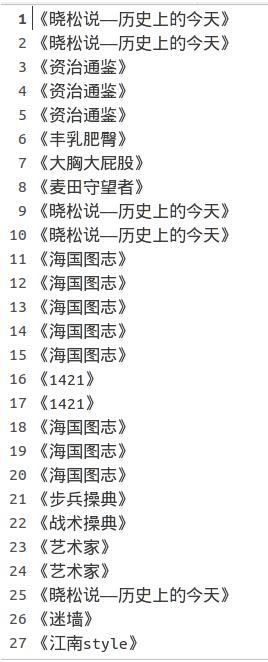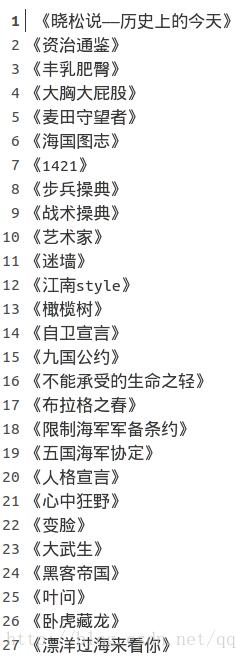- ubuntu12.04环境下使用kvm ioctl接口实现最简单的虚拟机
- Ubuntu 通过无线网络安装Ubuntu Server启动系统后连接无线网络的方法
- 在Ubuntu上搭建网桥的方法
- ubuntu 虚拟机上网方式及相关配置详解
CFSDN坚持开源创造价值,我们致力于搭建一个资源共享平台,让每一个IT人在这里找到属于你的精彩世界.
这篇CFSDN的博客文章python3.4.3下逐行读入txt文本并去重的方法由作者收集整理,如果你对这篇文章有兴趣,记得点赞哟.
读写文件时应注意的问题包括:
1.字符编码 。
2.操作完成即时关闭文件描述符 。
3.代码兼容性 。
几种方法:
|
1
2
3
4
5
6
7
8
9
10
11
12
13
14
15
16
17
18
19
20
21
22
23
24
25
26
27
28
29
30
31
32
33
34
35
36
37
38
39
40
41
42
43
44
45
46
47
48
49
50
51
52
53
54
55
56
57
58
59
60
61
62
63
|
#!/bin/python3
original_list1
=
[
" "
]
original_list2
=
[
" "
]
original_list3
=
[
" "
]
original_list4
=
[
" "
]
newlist1
=
[
" "
]
newlist2
=
[
" "
]
newlist3
=
[
" "
]
newlist4
=
[
" "
]
newtxt1
=
""
newtxt2
=
""
newtxt3
=
""
newtxt4
=
""
#first way to readline
f
=
open
(
"duplicate_txt.txt"
,
"r+"
)
# 返回一个文件对象
line
=
f.readline()
# 调用文件的 readline()方法
while
line:
original_list1.append(line)
line
=
f.readline()
f.close()
#use "set()" remove duplicate str in the list
# in this way,list will sort randomly
newlist1
=
list
(
set
(original_list1))
#newlist1 = {}.fromkeys(original_list1).keys() #faster
#rebuild a new txt
newtxt1
=
"".join(newlist1)
f1
=
open
(
"noduplicate1.txt"
,
"w"
)
f1.write(newtxt1)
f1.close()
###################################################################
#second way to readline
for
line
in
open
(
"duplicate_txt.txt"
,
"r+"
):
original_list2.append(line)
newlist2
=
list
(
set
(original_list2))
newlist2.sort(key
=
original_list2.index)
#sort
#newlist2 = sorted(set(original_list2),key=l1.index) #other way
newtxt2
=
"".join(newlist2)
f2
=
open
(
"noduplicate2.txt"
,
"w"
)
f2.write(newtxt2)
f2.close()
###################################################################
#third way to readline
f3
=
open
(
"duplicate_txt.txt"
,
"r"
)
original_list3
=
f3.readlines()
#读取全部内容 ,并以列表方式返回
for
i
in
original_list3:
#遍历去重
if
not
i
in
newlist3:
newlist3.append(i)
newtxt3
=
"".join(newlist3)
f4
=
open
(
"noduplicate3.txt"
,
"w"
)
f4.write(newtxt3)
f4.close()
###################################################################
#fourth way
f5
=
open
(
'duplicate_txt.txt'
,
"r+"
)
try
:
original_list4
=
f5.readlines()
[newlist4.append(i)
for
i
in
original_list4
if
not
i
in
newlist4]
newtxt4
=
"".join(newlist4)
f6
=
open
(
"noduplicate4.txt"
,
"w"
)
f6.write(newtxt4)
f6.close()
finally
:
f5.close()
|
结果:
去重前:

去重后(无序):

去重后(有序):

总结 。
这段下程序涉及文件读写操作以及链表list的操作,文章开头提到的几个问题,由于并没有使用中文,所以不关心编码,但这里还是要提一提
|
1
2
|
f
=
open
(
"test.txt"
,
"w"
)
f.write(u
"你好"
)
|
上面这段代码如果在python2中运行会报错 。

报错是因为程序没办法直接保存unicode字符串,要经过编码转换成str类型的二进制字节序列才可以保存.
write()方法会自动编码转换,默认使用ascii编码格式,而ascii不能处理中文,所以出现unicodeencodeerror.
正确方式是在调用write()方法前,手动格式转换,用utf-8或者gbk转换成str.
|
1
2
3
4
|
f
=
open
(
"test.txt"
,
"w"
)
text
=
u
"你好"
text
=
text.encode(encoding
=
'utf-8'
)
f.write(text)
|
关于close()问题
不关闭会有什么影响呢?操作完成后,不关闭文件,会对系统资源造成浪费,因为系统可打开的文件描述符数量是有限的。linux是65535.
一般来说close之后就ok了,但是也会存在特殊情况,比如说,在调用open()函数时就已经发生错误,权限不足,调用close()肯定报错。还有一种是在write()时,如果磁盘空间不足,报错,close()就没有机会执行了。正确的做法就是使用 try except 对异常进行捕获:
|
1
2
3
4
5
6
7
8
9
|
f
=
open
(
"test.txt"
,
"w"
)
try
:
text
=
u
"你好"
text
=
text.encode(encoding
=
'utf-8'
)
f.write(text)
except
: ioerror as e:
print
(
"oops,%s"
%
e.args[
0
])
finally
:
f.close()
|
更优雅的写法是用 with…as.
|
1
2
3
|
with
open
(
"test.txt"
,
"w"
) as f:
text
=
u
"你好"
f.write(text.encode(encoding
=
'utf-8'
))
|
文件对象实现上下午管理器协议,程序进入with语句时,会把文件对象赋值给变量f,在程序退出with时会自动的调用close()方法.
关于兼容性问题
python2和python3的open()函数是不一样的,后者可以在函数中指定字符编码格式.
如何解决python2和python3的兼容open()问题呢?
使用io模块下的open()函数,python2中的io.open等价与python3的open函数 。
|
1
2
3
|
from
io
import
open
with
open
(
"test.txt"
,
"w"
,encoding
=
'utf-8'
) as f:
f.write(u
"你好"
)
|
以上这篇python3.4.3下逐行读入txt文本并去重的方法就是小编分享给大家的全部内容了,希望能给大家一个参考,也希望大家多多支持我.
原文链接:https://blog.csdn.net/qq_30650153/article/details/77894942 。
最后此篇关于python3.4.3下逐行读入txt文本并去重的方法的文章就讲到这里了,如果你想了解更多关于python3.4.3下逐行读入txt文本并去重的方法的内容请搜索CFSDN的文章或继续浏览相关文章,希望大家以后支持我的博客! 。
我正在处理一组标记为 160 个组的 173k 点。我想通过合并最接近的(到 9 或 10 个组)来减少组/集群的数量。我搜索过 sklearn 或类似的库,但没有成功。 我猜它只是通过 knn 聚类
我有一个扁平数字列表,这些数字逻辑上以 3 为一组,其中每个三元组是 (number, __ignored, flag[0 or 1]),例如: [7,56,1, 8,0,0, 2,0,0, 6,1,
我正在使用 pipenv 来管理我的包。我想编写一个 python 脚本来调用另一个使用不同虚拟环境(VE)的 python 脚本。 如何运行使用 VE1 的 python 脚本 1 并调用另一个 p
假设我有一个文件 script.py 位于 path = "foo/bar/script.py"。我正在寻找一种在 Python 中通过函数 execute_script() 从我的主要 Python
这听起来像是谜语或笑话,但实际上我还没有找到这个问题的答案。 问题到底是什么? 我想运行 2 个脚本。在第一个脚本中,我调用另一个脚本,但我希望它们继续并行,而不是在两个单独的线程中。主要是我不希望第
我有一个带有 python 2.5.5 的软件。我想发送一个命令,该命令将在 python 2.7.5 中启动一个脚本,然后继续执行该脚本。 我试过用 #!python2.7.5 和http://re
我在 python 命令行(使用 python 2.7)中,并尝试运行 Python 脚本。我的操作系统是 Windows 7。我已将我的目录设置为包含我所有脚本的文件夹,使用: os.chdir("
剧透:部分解决(见最后)。 以下是使用 Python 嵌入的代码示例: #include int main(int argc, char** argv) { Py_SetPythonHome
假设我有以下列表,对应于及时的股票价格: prices = [1, 3, 7, 10, 9, 8, 5, 3, 6, 8, 12, 9, 6, 10, 13, 8, 4, 11] 我想确定以下总体上最
所以我试图在选择某个单选按钮时更改此框架的背景。 我的框架位于一个类中,并且单选按钮的功能位于该类之外。 (这样我就可以在所有其他框架上调用它们。) 问题是每当我选择单选按钮时都会出现以下错误: co
我正在尝试将字符串与 python 中的正则表达式进行比较,如下所示, #!/usr/bin/env python3 import re str1 = "Expecting property name
考虑以下原型(prototype) Boost.Python 模块,该模块从单独的 C++ 头文件中引入类“D”。 /* file: a/b.cpp */ BOOST_PYTHON_MODULE(c)
如何编写一个程序来“识别函数调用的行号?” python 检查模块提供了定位行号的选项,但是, def di(): return inspect.currentframe().f_back.f_l
我已经使用 macports 安装了 Python 2.7,并且由于我的 $PATH 变量,这就是我输入 $ python 时得到的变量。然而,virtualenv 默认使用 Python 2.6,除
我只想问如何加快 python 上的 re.search 速度。 我有一个很长的字符串行,长度为 176861(即带有一些符号的字母数字字符),我使用此函数测试了该行以进行研究: def getExe
list1= [u'%app%%General%%Council%', u'%people%', u'%people%%Regional%%Council%%Mandate%', u'%ppp%%Ge
这个问题在这里已经有了答案: Is it Pythonic to use list comprehensions for just side effects? (7 个答案) 关闭 4 个月前。 告
我想用 Python 将两个列表组合成一个列表,方法如下: a = [1,1,1,2,2,2,3,3,3,3] b= ["Sun", "is", "bright", "June","and" ,"Ju
我正在运行带有最新 Boost 发行版 (1.55.0) 的 Mac OS X 10.8.4 (Darwin 12.4.0)。我正在按照说明 here构建包含在我的发行版中的教程 Boost-Pyth
学习 Python,我正在尝试制作一个没有任何第 3 方库的网络抓取工具,这样过程对我来说并没有简化,而且我知道我在做什么。我浏览了一些在线资源,但所有这些都让我对某些事情感到困惑。 html 看起来

我是一名优秀的程序员,十分优秀!